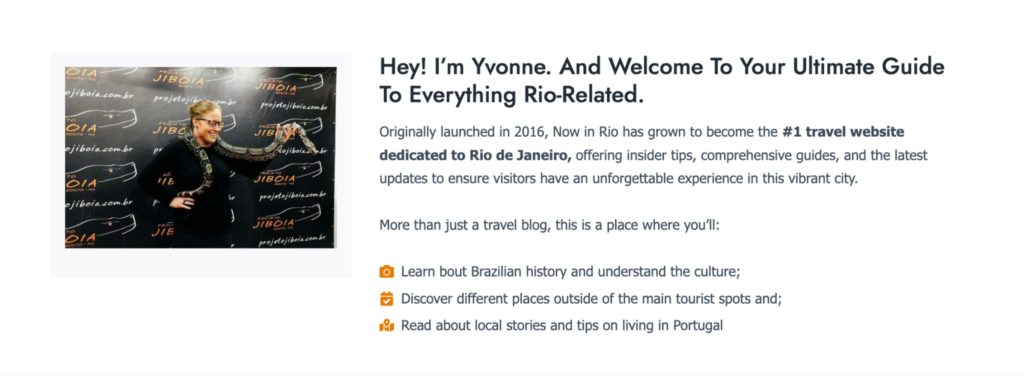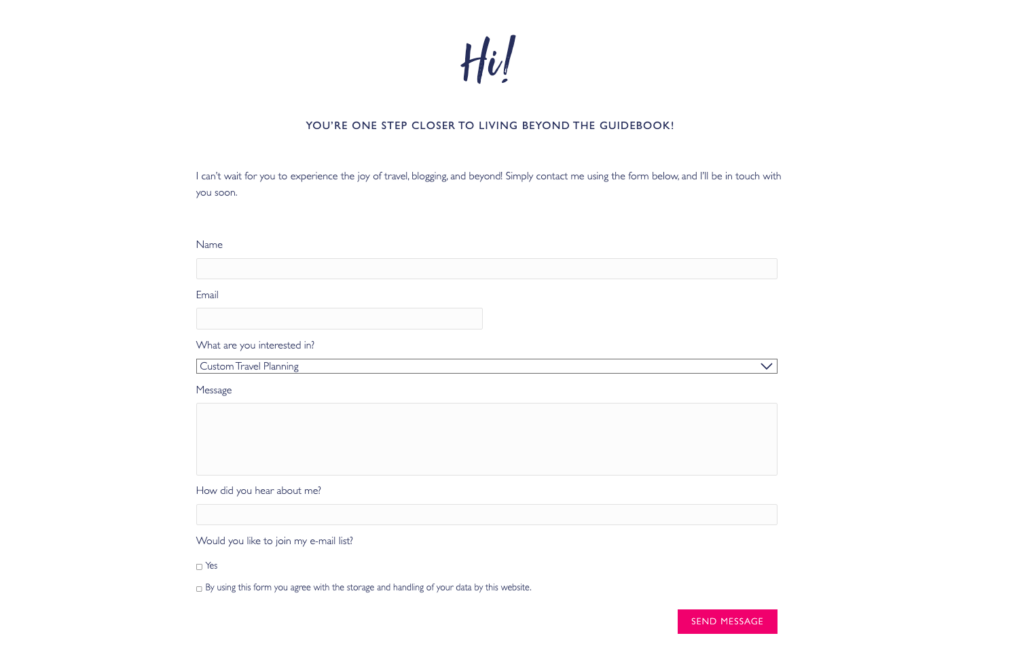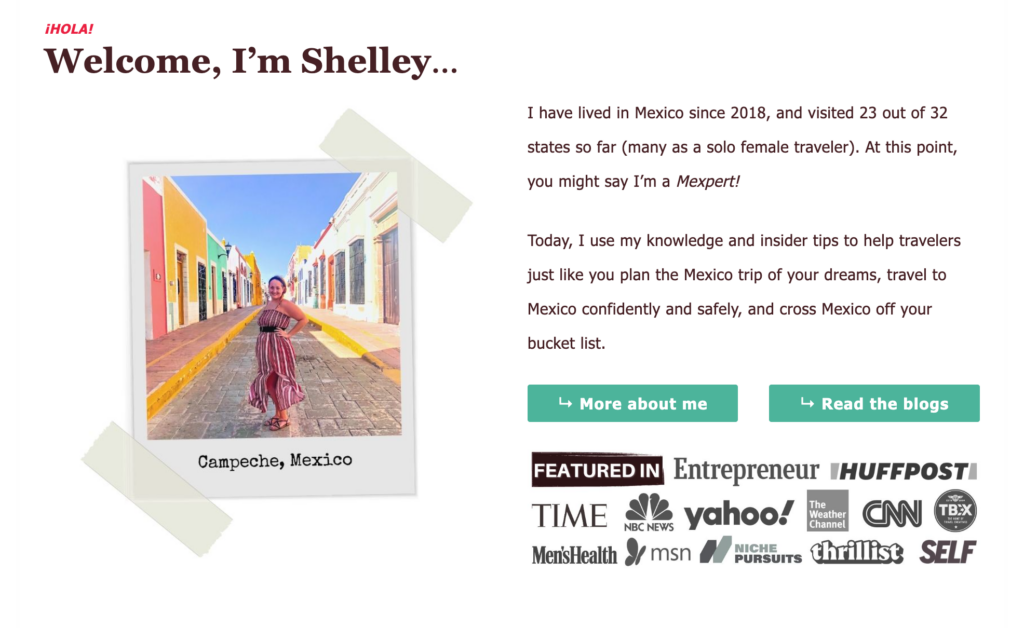Google’s recent updates shook the world of digital marketing. They’ve left travel bloggers struggling with drops in traffic and search rankings, as if everyone was forced to click an “I’m feeling unlucky” button. Now content creators are hungry for a solution, and some think they’ve found one: E-E-A-T.
We asked an SEO expert to help us figure out why E-E-A-T matters. Below, we’ll share some easy tips for improving your content and boosting your site’s performance and rankings.
What is E-E-A-T?
E-E-A-T is a Google acronym that stands for “Experience, Expertise, Authoritativeness, and Trustworthiness.” It checks if you know your stuff if your content meets users’ needs, and if your website can be trusted.
Experience
Experience means you’ve actually been there and done that. For travel bloggers, this means sharing your personal adventures and giving practical tips that you learned the hard way.
How to demonstrate your experience to Google:
- Use pronouns such as “I” and “we” to make your content personal
- Share specific stories and detailed experiences from your travels
- Include photos and videos from your trips to add authenticity

Ahmet Kaplan Elçi, SEO expert and founder of TAXIYO:
“Use precise phrases that describe your experience clearly. ‘On a street right by the Eiffel Tower, I saw…’
When telling a story, keep imagery and description separate. Start most paragraphs with a clear, direct description. Use abstract things like imagery sparingly compared with direct descriptions.
Example: ‘After the tour, I stopped by Cafe Such-and-Such, the busiest spot in the area, to have a coffee break. This is the closest cafe to the Eiffel Tower. You should definitely add it to your to-visit list when planning your trip.’
In this sentence, we share a personal experience while giving the reader tips or info. This is more helpful and increases relevance to important search terms:
- ‘Cafes close to the Eiffel Tower’
- ‘Cafe suggestions near the Eiffel Tower’
- ‘Eiffel Tower trip plan’
- ‘Things to do near the Eiffel Tower’”
Expertise
Expertise refers to the depth of knowledge displayed in the content. Google values content created by individuals who thoroughly understand their subject matter, so provide well-researched, accurate, and detailed information about destinations and travel topics.
How to demonstrate your expertise to Google:
- Research thoroughly and cite reputable sources
- Provide in-depth guides and useful tips that showcase your knowledge
- Include statistics and data where relevant
Example: When writing about a city’s public transportation system, include a detailed guide on how to navigate it, tips for purchasing tickets, and comparisons with other cities’ systems, including links.

Ahmet Kaplan Elçi, SEO expert and founder of TAXIYO:
“Keep in mind that Google won’t know if everything you say is actually true, or if you’ve actually been to the place. If you confidently write that a bus ticket costs $50 while it’s actually $30, Google might still consider you an expert, but readers who find out you’re wrong will lose their trust.
The bottom line: worry more about substance than style.”
Authoritativeness
Authoritativeness means how trustworthy you and your website are. Google wants to see that you’re a top source on a topic.
How to build authoritativeness:
- Try to get backlinks from respected travel blogs and news sites
- Be featured in or write guest posts for major travel publications
- Maintain an active and engaging social media presence

Ahmet Kaplan Elçi, SEO expert and founder of TAXIYO:
“Having other sites mention your brand or domain name in their content is good for your domain authority, as are, of course, links. Keep in mind that backlinks from closer to a site’s homepage will help you more than ones further away.
Example: a backlink from a page like example.com/hotel-reviews/post-url will do more for you than one from example.com/travel/trends/hotels/reviews/post-url because the first is closer to the homepage.
In addition, posts pinned to your site’s main page can achieve better rankings, especially if they stay there for at least three months. This gives Google enough time to assign them authority.
For instance, pin posts about beaches on your homepage at least three months before summer and highlight winter tourism articles in the fall. This way, you can soften seasonal fluctuations and maximize visibility all year round!”
Trustworthiness
Trustworthiness refers to the reliability and integrity of your content and site. Google wants to ensure that users can trust the information they find.
How to build trustworthiness:
- Always fact-check and update your content regularly
- Provide clear contact information and a detailed privacy policy
- Use HTTPS to ensure secure browsing for your readers
Example: At the end of each blog post, include a note about when the information was last updated and a link to your contact page. Or you can even add the year in your blog title, such as “The Best Hotels to Book in Porto in 2024.”
Wait – does E-E-A-T affect your site ranking?
Like many things related to SEO, this is up for debate, and SEO experts and travel bloggers have different opinions.
E-E-A-T and ranking factors
For instance, Google’s John Mueller suggested that EEAT is not a direct ranking factor, but a guideline for creating high-quality content.
On the other hand, a case study by Zyppy seemed to show that improvements in E-E-A-T led to a significant increase in site rankings, particularly after Google’s recent updates. Zyppy discovered that including first-hand experience and using first-person pronouns are important. These features are part of what Google looks for with E-E-A-T.
What’s the effect of Google updates?
Google updates often cause fluctuations in site rankings, and following E-E-A-T principles might be able to help reduce negative impacts.
One commenter on our previous article shared his experience of remaining unaffected by recent Google updates. He argued that this stability might be due to his strict adherence to E-E-A-T guidelines. Here’s what he said:

Nick Kembel, the creator of Spiritual Travels and Taiwan Obsessed:
“Neither of my sites have been impacted by any of the Google updates in the last year. Besides these ‘how-to’ guides and the more typical guides, I sometimes ignore keyword research and write fun articles with zero keyword volume simply because I want to or because I know people will enjoy them.
I also have content that is far more detailed, specific, and not available on any other websites in English… I feel that Google sees me as a major authority in my niche with content that is more detailed or simply not available anywhere else on the internet in English.”
So the direct impact of E-E-A-T on site rankings remains debated. However, some evidence suggests that following E-E-A-T guidelines can enhance content quality and improve site stability following Google updates.
In any case, having a trustworthy, authoritative definitely can’t be bad for business. But how exactly do you do that?
7 tips to update your content and nail E-E-A-T
1. Craft an engaging About page
Your About page is one of the first places visitors will look to learn more about you and your expertise. Make it engaging and informative. Here’s how:
- Share your story: explain your background, why you started the blog, and your passion for travel. Personal anecdotes can make your story more relatable and authentic.
- Highlight your expertise: mention relevant qualifications, experiences, or notable achievements. For example, showcase it here if you’ve been featured in major publications or have significant travel experience.
- Use testimonials: if you’ve received positive feedback from readers or endorsements from reputable sources, include it to build credibility.

2. Publish a comprehensive Contact page
A well-crafted Contact page signals transparency and openness, which are critical components of trustworthiness.
- Provide multiple contact options: include an email address, social media profiles, and a contact form. Ensure your contact details are easy to find and use.
- Add a physical address: if you have a business address, include it. This adds an extra layer of credibility, showing you’re legit.
- Incorporate a privacy policy: clearly state how you handle users’ information. This transparency can enhance trust and show that you comply with privacy regulations.

3. Publish authoritative content
Creating authoritative content involves thorough research and citing reliable sources. Here are some steps to follow:
- Use credible sources: reference data, statistics, and insights from reputable sources.
- Provide detailed information: go beyond surface-level content by offering in-depth content that readers might not find elsewhere. Provide something new based on your personal experiences.
- Update regularly: keep your content up-to-date with the latest information. Regular updates signal to Google and your readers that your site is active and reliable.
4. Write a great intro with the SPEAR framework
An engaging introduction is an important component of any successful marketing content because it’s the first point of contact with your reader when their attention is at a maximum. The SPEAR framework can help here:
- Specificity: be clear about what the post is about. Avoid vague statements.
- Promise: tell the reader what they will gain from reading the post.
- Example: use a relatable example to illustrate the topic.
- Anchor: connect the introduction to the reader’s needs or interests.
- Relevance: ensure the introduction is relevant to the rest of the content.
5. Incorporate personal experiences and photos
Personal stories and unique photos can engage readers deeply, keeping them on your site longer and encouraging them to return.
- Sharing firsthand experiences adds authenticity, making your content more relatable and trustworthy. Include details from your trips, such as interactions with locals, unique places you visited, or challenges you faced and overcame.
- Instead of just listing facts, weave them into engaging narratives highlighting your personal journey.
- Remember to share practical tips based on your experiences. For instance, if you had a particularly good or bad experience with a specific airline, hotel, or tour company, mention this to help your readers make informed decisions.
Also use high-quality, relevant photos you took yourself (rather than stock images). Google values unique content, and personal photos make your blog stand out and show your first-hand experience. This aligns with E-E-A-T principles.
Add pictures throughout your content to maintain reader interest and break up long paragraphs.
6. Show off your credentials
If you have certifications, awards, or memberships in professional organizations, display them prominently on your site.

7. Create an author box
An author box is a small section typically found at the end of blog posts. It usually includes the author’s name, a photo, a brief bio, and links to social media profiles or personal websites.
This can help with E-E-A-T, as it:
- Allows readers to connect with the author personally, enhancing credibility
- Highlights your qualifications in the industry to build your authority
- Helps you maintain a consistent, professional image across posts
For more on creating an author box, check out this Kadence tutorial.
BONUS: don’t forget about the technical stuff
A technically sound website is crucial for trustworthiness. This can include:
- Fast loading times: otherwise, impatient users will click away. Test your website speed via GTmetrix.
- Mobile optimization: make sure your site is fully functional and aesthetically pleasing on mobile devices.
- Secure browsing: use HTTPS to protect users’ data and enhance trust.
Final thoughts: should you worry about E-E-A-T?
Whether or not Google uses it at the algorithmic level, E-E-A-T is an excellent checklist for content preparation. It will likely help rather than hinder the growth of your business.
Content prepared in accordance with E-E-A-T rules is fundamentally optimized not only for existing search engines like Google, but also for new systems that may emerge in the future. Readers will thank you for creating valuable and credible material!
What are your thoughts on E-E-A-T? Do you think it’s affecting your site rankings, especially following the Google updates? We’d love to hear your feedback and stories – that helps our community learn and grow.





